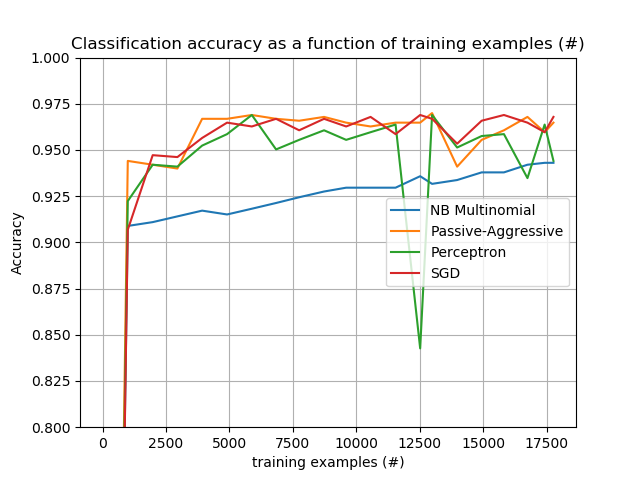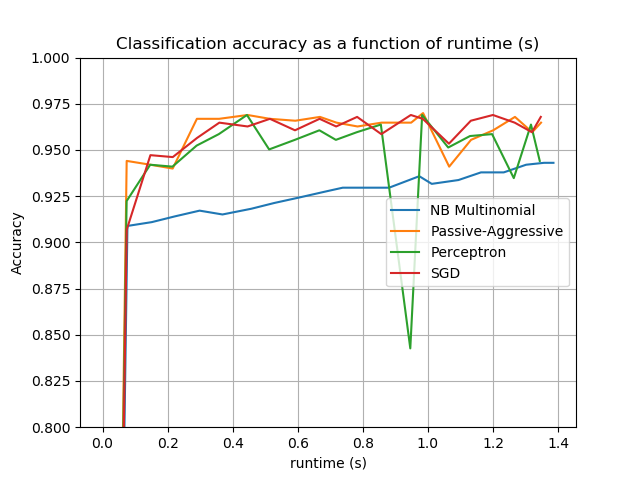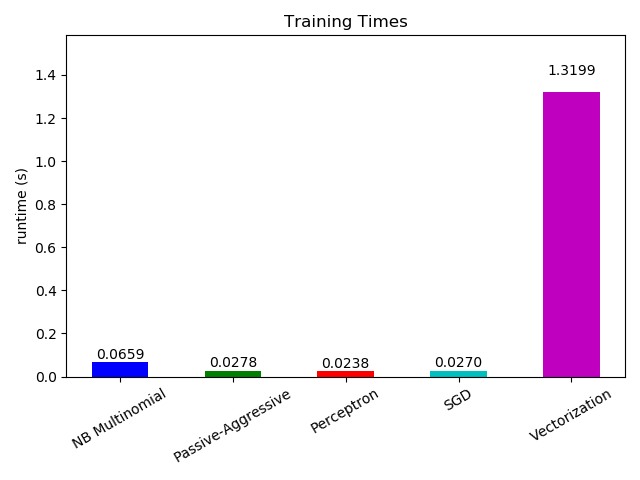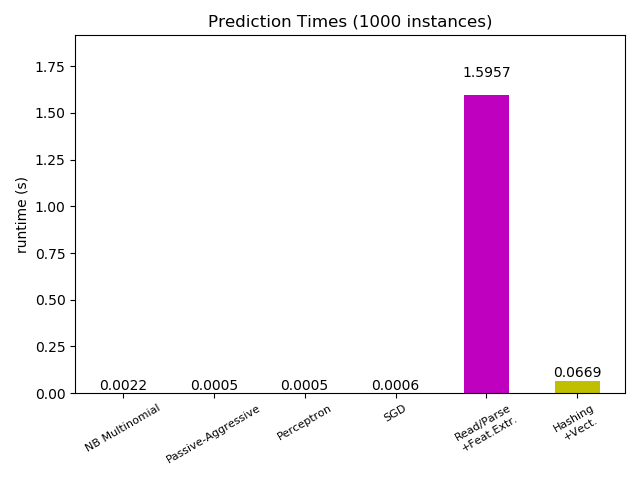Note
Click here to download the full example code
Out-of-core classification of text documents¶
This is an example showing how scikit-learn can be used for classification using an out-of-core approach: learning from data that doesn’t fit into main memory. We make use of an online classifier, i.e., one that supports the partial_fit method, that will be fed with batches of examples. To guarantee that the features space remains the same over time we leverage a HashingVectorizer that will project each example into the same feature space. This is especially useful in the case of text classification where new features (words) may appear in each batch.
The dataset used in this example is Reuters-21578 as provided by the UCI ML repository. It will be automatically downloaded and uncompressed on first run.
The plot represents the learning curve of the classifier: the evolution of classification accuracy over the course of the mini-batches. Accuracy is measured on the first 1000 samples, held out as a validation set.
To limit the memory consumption, we queue examples up to a fixed amount before feeding them to the learner.
# Authors: Eustache Diemert <eustache@diemert.fr>
# @FedericoV <https://github.com/FedericoV/>
# License: BSD 3 clause
from glob import glob
import itertools
import os.path
import re
import tarfile
import time
import sys
import numpy as np
import matplotlib.pyplot as plt
from matplotlib import rcParams
from html.parser import HTMLParser
from urllib.request import urlretrieve
from sklearn.datasets import get_data_home
from sklearn.feature_extraction.text import HashingVectorizer
from sklearn.linear_model import SGDClassifier
from sklearn.linear_model import PassiveAggressiveClassifier
from sklearn.linear_model import Perceptron
from sklearn.naive_bayes import MultinomialNB
def _not_in_sphinx():
# Hack to detect whether we are running by the sphinx builder
return '__file__' in globals()
Main¶
Create the vectorizer and limit the number of features to a reasonable maximum
vectorizer = HashingVectorizer(decode_error='ignore', n_features=2 ** 18,
alternate_sign=False)
# Iterator over parsed Reuters SGML files.
data_stream = stream_reuters_documents()
# We learn a binary classification between the "acq" class and all the others.
# "acq" was chosen as it is more or less evenly distributed in the Reuters
# files. For other datasets, one should take care of creating a test set with
# a realistic portion of positive instances.
all_classes = np.array([0, 1])
positive_class = 'acq'
# Here are some classifiers that support the `partial_fit` method
partial_fit_classifiers = {
'SGD': SGDClassifier(max_iter=5, tol=1e-3),
'Perceptron': Perceptron(tol=1e-3),
'NB Multinomial': MultinomialNB(alpha=0.01),
'Passive-Aggressive': PassiveAggressiveClassifier(tol=1e-3),
}
def get_minibatch(doc_iter, size, pos_class=positive_class):
"""Extract a minibatch of examples, return a tuple X_text, y.
Note: size is before excluding invalid docs with no topics assigned.
"""
data = [('{title}\n\n{body}'.format(**doc), pos_class in doc['topics'])
for doc in itertools.islice(doc_iter, size)
if doc['topics']]
if not len(data):
return np.asarray([], dtype=int), np.asarray([], dtype=int)
X_text, y = zip(*data)
return X_text, np.asarray(y, dtype=int)
def iter_minibatches(doc_iter, minibatch_size):
"""Generator of minibatches."""
X_text, y = get_minibatch(doc_iter, minibatch_size)
while len(X_text):
yield X_text, y
X_text, y = get_minibatch(doc_iter, minibatch_size)
# test data statistics
test_stats = {'n_test': 0, 'n_test_pos': 0}
# First we hold out a number of examples to estimate accuracy
n_test_documents = 1000
tick = time.time()
X_test_text, y_test = get_minibatch(data_stream, 1000)
parsing_time = time.time() - tick
tick = time.time()
X_test = vectorizer.transform(X_test_text)
vectorizing_time = time.time() - tick
test_stats['n_test'] += len(y_test)
test_stats['n_test_pos'] += sum(y_test)
print("Test set is %d documents (%d positive)" % (len(y_test), sum(y_test)))
def progress(cls_name, stats):
"""Report progress information, return a string."""
duration = time.time() - stats['t0']
s = "%20s classifier : \t" % cls_name
s += "%(n_train)6d train docs (%(n_train_pos)6d positive) " % stats
s += "%(n_test)6d test docs (%(n_test_pos)6d positive) " % test_stats
s += "accuracy: %(accuracy).3f " % stats
s += "in %.2fs (%5d docs/s)" % (duration, stats['n_train'] / duration)
return s
cls_stats = {}
for cls_name in partial_fit_classifiers:
stats = {'n_train': 0, 'n_train_pos': 0,
'accuracy': 0.0, 'accuracy_history': [(0, 0)], 't0': time.time(),
'runtime_history': [(0, 0)], 'total_fit_time': 0.0}
cls_stats[cls_name] = stats
get_minibatch(data_stream, n_test_documents)
# Discard test set
# We will feed the classifier with mini-batches of 1000 documents; this means
# we have at most 1000 docs in memory at any time. The smaller the document
# batch, the bigger the relative overhead of the partial fit methods.
minibatch_size = 1000
# Create the data_stream that parses Reuters SGML files and iterates on
# documents as a stream.
minibatch_iterators = iter_minibatches(data_stream, minibatch_size)
total_vect_time = 0.0
# Main loop : iterate on mini-batches of examples
for i, (X_train_text, y_train) in enumerate(minibatch_iterators):
tick = time.time()
X_train = vectorizer.transform(X_train_text)
total_vect_time += time.time() - tick
for cls_name, cls in partial_fit_classifiers.items():
tick = time.time()
# update estimator with examples in the current mini-batch
cls.partial_fit(X_train, y_train, classes=all_classes)
# accumulate test accuracy stats
cls_stats[cls_name]['total_fit_time'] += time.time() - tick
cls_stats[cls_name]['n_train'] += X_train.shape[0]
cls_stats[cls_name]['n_train_pos'] += sum(y_train)
tick = time.time()
cls_stats[cls_name]['accuracy'] = cls.score(X_test, y_test)
cls_stats[cls_name]['prediction_time'] = time.time() - tick
acc_history = (cls_stats[cls_name]['accuracy'],
cls_stats[cls_name]['n_train'])
cls_stats[cls_name]['accuracy_history'].append(acc_history)
run_history = (cls_stats[cls_name]['accuracy'],
total_vect_time + cls_stats[cls_name]['total_fit_time'])
cls_stats[cls_name]['runtime_history'].append(run_history)
if i % 3 == 0:
print(progress(cls_name, cls_stats[cls_name]))
if i % 3 == 0:
print('\n')
Out:
downloading dataset (once and for all) into /home/circleci/scikit_learn_data/reuters
untarring Reuters dataset...
done.
Test set is 966 documents (88 positive)
SGD classifier : 994 train docs ( 121 positive) 966 test docs ( 88 positive) accuracy: 0.907 in 0.74s ( 1342 docs/s)
Perceptron classifier : 994 train docs ( 121 positive) 966 test docs ( 88 positive) accuracy: 0.922 in 0.74s ( 1338 docs/s)
NB Multinomial classifier : 994 train docs ( 121 positive) 966 test docs ( 88 positive) accuracy: 0.909 in 0.75s ( 1327 docs/s)
Passive-Aggressive classifier : 994 train docs ( 121 positive) 966 test docs ( 88 positive) accuracy: 0.944 in 0.75s ( 1323 docs/s)
SGD classifier : 3924 train docs ( 496 positive) 966 test docs ( 88 positive) accuracy: 0.957 in 2.20s ( 1784 docs/s)
Perceptron classifier : 3924 train docs ( 496 positive) 966 test docs ( 88 positive) accuracy: 0.952 in 2.20s ( 1782 docs/s)
NB Multinomial classifier : 3924 train docs ( 496 positive) 966 test docs ( 88 positive) accuracy: 0.917 in 2.21s ( 1778 docs/s)
Passive-Aggressive classifier : 3924 train docs ( 496 positive) 966 test docs ( 88 positive) accuracy: 0.967 in 2.21s ( 1776 docs/s)
SGD classifier : 6836 train docs ( 793 positive) 966 test docs ( 88 positive) accuracy: 0.967 in 3.82s ( 1791 docs/s)
Perceptron classifier : 6836 train docs ( 793 positive) 966 test docs ( 88 positive) accuracy: 0.950 in 3.82s ( 1790 docs/s)
NB Multinomial classifier : 6836 train docs ( 793 positive) 966 test docs ( 88 positive) accuracy: 0.921 in 3.82s ( 1787 docs/s)
Passive-Aggressive classifier : 6836 train docs ( 793 positive) 966 test docs ( 88 positive) accuracy: 0.967 in 3.83s ( 1786 docs/s)
SGD classifier : 9597 train docs ( 1139 positive) 966 test docs ( 88 positive) accuracy: 0.963 in 5.39s ( 1779 docs/s)
Perceptron classifier : 9597 train docs ( 1139 positive) 966 test docs ( 88 positive) accuracy: 0.955 in 5.40s ( 1778 docs/s)
NB Multinomial classifier : 9597 train docs ( 1139 positive) 966 test docs ( 88 positive) accuracy: 0.930 in 5.40s ( 1776 docs/s)
Passive-Aggressive classifier : 9597 train docs ( 1139 positive) 966 test docs ( 88 positive) accuracy: 0.965 in 5.41s ( 1775 docs/s)
SGD classifier : 12513 train docs ( 1558 positive) 966 test docs ( 88 positive) accuracy: 0.969 in 7.02s ( 1783 docs/s)
Perceptron classifier : 12513 train docs ( 1558 positive) 966 test docs ( 88 positive) accuracy: 0.843 in 7.02s ( 1783 docs/s)
NB Multinomial classifier : 12513 train docs ( 1558 positive) 966 test docs ( 88 positive) accuracy: 0.936 in 7.02s ( 1781 docs/s)
Passive-Aggressive classifier : 12513 train docs ( 1558 positive) 966 test docs ( 88 positive) accuracy: 0.965 in 7.03s ( 1781 docs/s)
SGD classifier : 14935 train docs ( 1863 positive) 966 test docs ( 88 positive) accuracy: 0.966 in 8.52s ( 1752 docs/s)
Perceptron classifier : 14935 train docs ( 1863 positive) 966 test docs ( 88 positive) accuracy: 0.958 in 8.53s ( 1751 docs/s)
NB Multinomial classifier : 14935 train docs ( 1863 positive) 966 test docs ( 88 positive) accuracy: 0.938 in 8.53s ( 1750 docs/s)
Passive-Aggressive classifier : 14935 train docs ( 1863 positive) 966 test docs ( 88 positive) accuracy: 0.955 in 8.54s ( 1749 docs/s)
SGD classifier : 17417 train docs ( 2171 positive) 966 test docs ( 88 positive) accuracy: 0.960 in 9.98s ( 1745 docs/s)
Perceptron classifier : 17417 train docs ( 2171 positive) 966 test docs ( 88 positive) accuracy: 0.964 in 9.98s ( 1744 docs/s)
NB Multinomial classifier : 17417 train docs ( 2171 positive) 966 test docs ( 88 positive) accuracy: 0.943 in 9.99s ( 1743 docs/s)
Passive-Aggressive classifier : 17417 train docs ( 2171 positive) 966 test docs ( 88 positive) accuracy: 0.960 in 9.99s ( 1743 docs/s)
Plot results¶
def plot_accuracy(x, y, x_legend):
"""Plot accuracy as a function of x."""
x = np.array(x)
y = np.array(y)
plt.title('Classification accuracy as a function of %s' % x_legend)
plt.xlabel('%s' % x_legend)
plt.ylabel('Accuracy')
plt.grid(True)
plt.plot(x, y)
rcParams['legend.fontsize'] = 10
cls_names = list(sorted(cls_stats.keys()))
# Plot accuracy evolution
plt.figure()
for _, stats in sorted(cls_stats.items()):
# Plot accuracy evolution with #examples
accuracy, n_examples = zip(*stats['accuracy_history'])
plot_accuracy(n_examples, accuracy, "training examples (#)")
ax = plt.gca()
ax.set_ylim((0.8, 1))
plt.legend(cls_names, loc='best')
plt.figure()
for _, stats in sorted(cls_stats.items()):
# Plot accuracy evolution with runtime
accuracy, runtime = zip(*stats['runtime_history'])
plot_accuracy(runtime, accuracy, 'runtime (s)')
ax = plt.gca()
ax.set_ylim((0.8, 1))
plt.legend(cls_names, loc='best')
# Plot fitting times
plt.figure()
fig = plt.gcf()
cls_runtime = [stats['total_fit_time']
for cls_name, stats in sorted(cls_stats.items())]
cls_runtime.append(total_vect_time)
cls_names.append('Vectorization')
bar_colors = ['b', 'g', 'r', 'c', 'm', 'y']
ax = plt.subplot(111)
rectangles = plt.bar(range(len(cls_names)), cls_runtime, width=0.5,
color=bar_colors)
ax.set_xticks(np.linspace(0, len(cls_names) - 1, len(cls_names)))
ax.set_xticklabels(cls_names, fontsize=10)
ymax = max(cls_runtime) * 1.2
ax.set_ylim((0, ymax))
ax.set_ylabel('runtime (s)')
ax.set_title('Training Times')
def autolabel(rectangles):
"""attach some text vi autolabel on rectangles."""
for rect in rectangles:
height = rect.get_height()
ax.text(rect.get_x() + rect.get_width() / 2.,
1.05 * height, '%.4f' % height,
ha='center', va='bottom')
plt.setp(plt.xticks()[1], rotation=30)
autolabel(rectangles)
plt.tight_layout()
plt.show()
# Plot prediction times
plt.figure()
cls_runtime = []
cls_names = list(sorted(cls_stats.keys()))
for cls_name, stats in sorted(cls_stats.items()):
cls_runtime.append(stats['prediction_time'])
cls_runtime.append(parsing_time)
cls_names.append('Read/Parse\n+Feat.Extr.')
cls_runtime.append(vectorizing_time)
cls_names.append('Hashing\n+Vect.')
ax = plt.subplot(111)
rectangles = plt.bar(range(len(cls_names)), cls_runtime, width=0.5,
color=bar_colors)
ax.set_xticks(np.linspace(0, len(cls_names) - 1, len(cls_names)))
ax.set_xticklabels(cls_names, fontsize=8)
plt.setp(plt.xticks()[1], rotation=30)
ymax = max(cls_runtime) * 1.2
ax.set_ylim((0, ymax))
ax.set_ylabel('runtime (s)')
ax.set_title('Prediction Times (%d instances)' % n_test_documents)
autolabel(rectangles)
plt.tight_layout()
plt.show()
Total running time of the script: ( 0 minutes 12.190 seconds)





